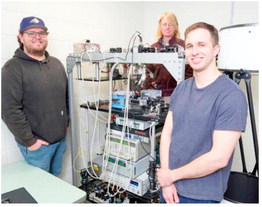Technology Could Help Make Weather Forecasting More Accurate


Twice daily at 900 locations around the world, scientists and researchers launch weather balloons as high as 30 miles into Earth’s atmosphere, providing meteorologists and weather prognosticators the data necessary to forecast conditions on the ground for several days at a time.
Now, thanks to groundbased tools developed by a Montana State University researcher, those data can be updated continuously, rather than twice daily, which can facilitate more accurate and timely forecasts.
In partnership with the National Science Foundation’s National Center for Atmospheric Research and NASA, MSU’s Kevin Repasky has developed this suite of instruments over the past 25 years. Called MicroPulse Differential Absorption Lidar, or DIAL, the technology has been patented by MSU’s Technology Transfer Office, which recently licensed to a Japanese company for commercialization.
“It’s really fun to see the full lifecycle of a project like this,” said Repasky, who is a professor of electrical and computer engineering in MSU’s Norm Asbjornson College of Engineering. “It begins with initial ideas, building and improving instrument prototypes, developing computer algorithms for interpreting data, and finally deploying instruments in the field. It is gratifying to see these instruments become accepted in the research community, having patents issued, and having this technology licensed and potential commercial instruments come out of this.”
The MicroPulse DIAL instruments utilize diode-lasers to send a pulse of light into the atmosphere. The pulse of light is approximately 100 meters long. This light is then scattered from atmospheric molecules including nitrogen, oxygen and water vapor as well as atmospheric aerosols such as dust particles. The time it takes for the light to travel in the atmosphere and be collected by the telescope provides range information, and the different properties of the scattered light provide information about atmospheric properties including humidity, temperature, pressure, windspeed and atmospheric structure.
The cost of a MicroPulse DIAL instrument, he said, is comparable to what it costs to launch a year’s worth of weather balloons from a single location. Housed in a broom-closet-sized environmental enclosure, the Micro-Pulse DIAL can be deployed for long-term unattended operation. A network of MicroPulse DIAL instruments can be used to supplement the information provided by weather balloons. This continuous flow of data, Repasky said, helps provide better weather predictions for events such as severe thunderstorms, as well as the spatial distribution and amount of precipitation. This can, for example, impact the agricultural sector, which is a significant driver of Montana’s economy.
“The instruments that we’re using to gather temperature, humidity, windspeed and direction throughout the troposphere, the lowest part of the atmosphere, is important for understanding the state of the atmosphere,” Repasky said. “We’re also looking at other information about the atmosphere, such as how buoyant a parcel of air is, which is important for understanding the process of convection based on the data provided by the Micropulse DIAL instruments.”
Convection, he said, is the process by which heat from the ground causes air parcels to rise into the atmosphere, potentially fueling storms.
Since the project began 25 years ago, Repasky has worked with eight graduate students and five undergraduate students, all of whom have gone on to successful careers at universities, national laboratories and the private sector.
“It’s fun to see the success of these students as they start on these projects, as they mature and develop and they go out and do wonderful things,” he said. “It’s just really great to see the students succeed.”


